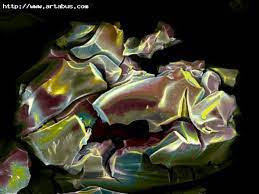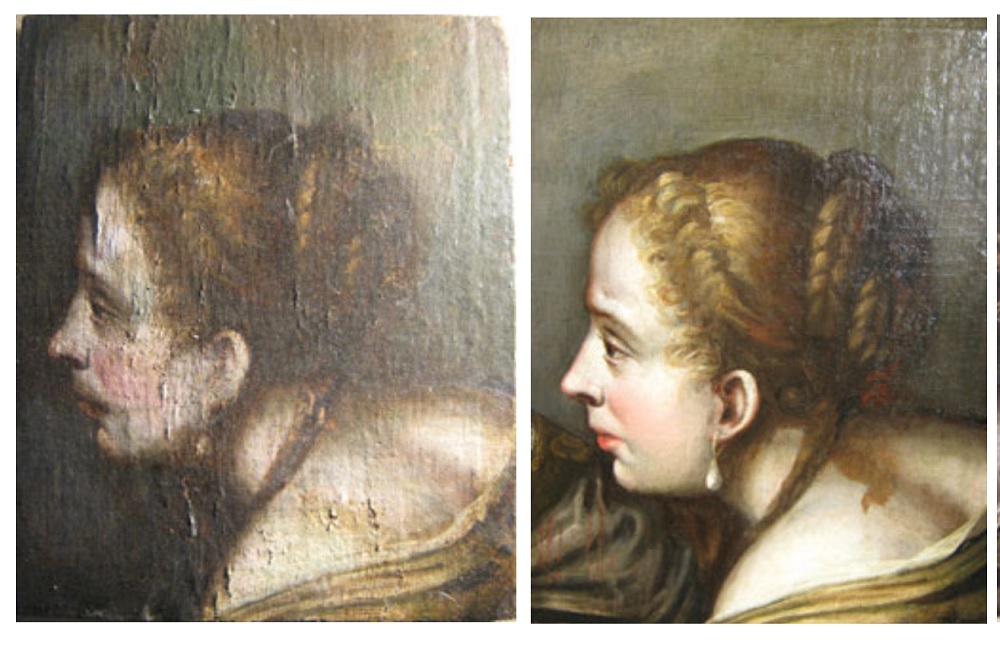Week 8 - Nanotechnology and Art
 |
| Ancient shard of golden luster ceramics from the 9th century |
An example of an extremely influential piece of nanotechnology is the Scanning Tunnel Microscope. This machine utilizes a new technique to “view” the structure of atoms -- essentially, it utilizes a thin needle that detects the surface and then maps out the position of the atoms. This microscope has been used to discern some breakout revelations at the atomic level, such as identifying the structure of minuscule molecules. For instance, it was utilized to depict quantum corrals or spacial oscillation patterns that are caused by the scattering of two-dimensional electrons off atoms (Scanning Tunneling Microscopy).
 |
| Cris Orfescu's digital nanosculpture, "In Pieces" |
Such atomic microscopes, however, have additionally been used for a multitude of artistic endeavors. For example, the Academy of NanoArt is an international organization dedicated to creating NanoArt works in science-labs/art-studios by utilizing “electron, atomic force, and other advanced microscopes to visualize nanosculptures and nanolandscapes” (Academy of NanoArt). In fact, their developed art projects are created with the goal of stimulating researchers and scientists to consider the benefits of adding both aesthetic and emotional value to their experimental work. Indeed, I would argue that doing so is incredibly helpful in how it stimulates both the researcher’s and an observer’s perception and understanding of the created project. Moreover, I believe that this emotional and artistic addition to nanotechnology truly accentuates the groundbreaking nature and relative importance of the work these scientists are engaging in.
Overall, nanotechnology has proven to be extremely beneficial across a multitude of fields. Some important developments catalyzed by nanotechnology include the boost of nanomedicine, particularly in developing treatments or drugs that are less toxic to the user. Moreover, nanotechnology is also being developed in order to aid in the conservation of art and salvaging centuries-old artwork. However, it is not without its downfalls -- many groups such as the International Union of Food Workers criticize the use of nanoparticles, particularly in the field of food and agriculture. They argue that because the use of nanoparticles within food is so new, the impacts of such molecules upon people are currently unknown. However, they also suggest that there is indeed evidence the consumption of such particles is hazardous (3).
 |
| A piece before and after it has been restored and conserved. |
Indeed, I believe that although nanoscience and nanotechnology do indeed have the potential to be amazingly beneficial, and in fact, they already aided so much in many fields across science and art. However, it is indeed important to recall that we shouldn’t immediately utilize nanoparticles in any which way -- this field has not been explored to a degree where I would suggest ingesting or inserting manipulated nanoparticles into one’s self. Ultimately, I believe that nanotechnology's benefits can best be observed in the intersection of nanotechnology due to its potential to impact societal perception, response, and understanding of these new developments and any messages we wish to reveal with them.
WORKS CITED
“About the Academy of NanoArt.” Academy of NanoArt, nanoart.org/.
“International Union of Food Workers Calls for Moratorium on Nano in Food and Agriculture.” Friends of the Earth: Emerging Tech Project, 29 Mar. 2007, emergingtech.foe.org.au/195/.
“Scanning Tunneling Microscopy.” Nanoscience Instruments, 26 July 2018, www.nanoscience.com/techniques/scanning-tunneling-microscopy/.
Sciau, Philippe. “Nanoparticles in Ancient Materials: The Metallic Lustre Decorations of Medieval Ceramics.” The Delivery of Nanoparticles, 2012, doi:10.5772/34080.
Sunipapramanik. “Art Conservation and Nanotechnology: A Wonderful Confluence of Arts and Sciences.” Sustainable Nano, 12 May 2017, sustainable-nano.com/2017/05/12/art-conservation-and-nanotechnology/.
“What Is Nanotechnology?” National Nanotechnology Initiative, www.nano.gov/nanotech-101/what/definition.
Climent-Font, Aurelio. “Commentary: Luster Ceramics: a 9th Century AD Nanotechnology.” Journal of Nanophotonics, International Society for Optics and Photonics, www.spiedigitallibrary.org/journals/journal-of-nanophotonics/volume-6/issue-01/060303/Commentary-Luster-ceramics-a-9th-century-AD-nanotechnology/10.1117/1.JNP.6.060303.full?SSO=1.
Orfescu, Cris. “In Pieces.” Academy of NanoArt, nanoart.org/nanoart-gallery-moon-museum/.
Newton, William. “How A Restorer Brought My Old Master Painting Back To Life.” The Federalist, 11 Mar. 2019, thefederalist.com/2019/03/06/restorer-brought-old-master-painting-back-life/.
Comments
Post a Comment